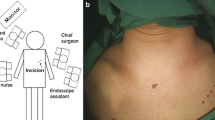Abstract
Surgical management of Graves’ disease is still debated. We report our current experience with thyroidectomy for Graves’ disease at a tertiary center. A retrospective database of 132 patients who underwent surgery for Graves’ disease from January 1985 to December 2008 was collected. During that period, 16 patients underwent subtotal thyroidectomy and 116 patients underwent near total thyroidectomy. Eighty-seven patients (66%) underwent surgery for recurrent disease after medical therapy. Forty-five patients (34%) had surgery as a primary treatment, the indications were large goiter size in 22 (17%), patient preference in 19 (14%), and associated cold nodule in 3 (2%). The incidence of cancer was 4.4%. Permanent hypoparathyroidism was observed in one patient who underwent a second surgery for recurrence. Unilateral transitory vocal cord palsy was observed in nine patients (7%), bilateral transitory vocal cord palsy was observed in one patient, and no definitive vocal cord palsy was observed. Two patients (1.5%) experienced post-operative hemorrhagia requiring surgical revision. Near total thyroidectomy for Graves’ disease provides an immediate and definitive treatment with a low complication rate. Near total thyroidectomy offers an appropriate treatment for coexisting malignancy. This procedure can be safely recommended as a primary treatment, in experienced hands.
Similar content being viewed by others
References
Reid JR, Wheeler SF (2005) Hyperthyroidism: diagnosis and treatment. Am Fam Physician 72(4):623–630
Kaplan MM, Meier DA, Dworkin HJ (1998) Treatment of hyperthyroidism with radioactive iodine. Endocrinol Metab Clin North Am 27(1):205–223
Pradeep PV, Agarwal A, Baxi M et al (2007) Safety and efficacy of surgical management of hyperthyroidism: 15-year experience from a tertiary care center in a developing country. World J Surg 31(2):306–312 discussion 313
Witte J, Goretzki PE, Dotzenrath C et al (2000) Surgery for Graves’ disease: total versus subtotal thyroidectomy-results of a prospective randomized trial. World J Surg 24(11):1303–1311
Chang DC, Wheeler MH, Woodcock JP et al (1987) The effect of preoperative Lugol’s iodine on thyroid blood flow in patients with Graves’ hyperthyroidism. Surgery 102(6):1055–1061
Lahey FH (1949) Technic of subtotal thyroidectomy. Surg Clin North Am 29(3):641–658
Glinoer D, Hesch RD, Lagasse R, Laurberg P (1987) The management of hyperthyroidism due to Graves’ disease in Europe in 1986: results of an international survey. Acta Endocrinol 115:1–23
Weetman AP (2000) Graves’ disease. N Engl J Med 343(17):1236–1248
Tallstedt L, Lundell G, Torring O et al (1992) Occurrence of ophthalmopathy after treatment for Graves’ hyperthyroidism. The Thyroid Study Group. N Engl J Med 326(26):1733–1738
Glinoer D, De Nayer P, Bex M (2001) Effects of thyroxine administration, thyrotropin-receptor antibodies and smoking on the risk of recurrence in Graves’ hyperthyroidism treated with antithyroid drugs: a double blind prospective randomized study. Eur J Endocrinol 144:475–483
Abraham-Nordling M, Torring O, Hamberger B et al (2005) Graves’ disease: a long-term quality-of-life follow up of patients randomized to treatment with antithyroid drugs, radioiodine, or surgery. Thyroid 15(11):1279–1286
Werga-Kjellman P, Zedenius J, Tallstedt L, Träisk F, Lundell G, Wallin G (2001) Surgical treatment of hyperthyroidism: a ten-year experience. Thyroid 11(2):187–192
Miccoli P, Vitti P, Rago T, Iacconi P, Bartalena L, Bogazzi F, Fiore E, Valeriano R, Chiovato L, Rocchi R, Pinchera A (1996) Surgical treatment of Graves’ disease: subtotal or total thyroidectomy? Surgery 120:1020–1025
Weber KJ, Solorzano CC, Lee JK et al (2006) Thyroidectomy remains an effective treatment option for Graves’ disease. Am J Surg 191(3):400–405
Barakate MS, Agarwal G, Reeve TS et al (2002) Total thyroidectomy is now the preferred option for the surgical management of Graves’ disease. ANZ J Surg 72(5):321–324
Palit TK, Miller CC 3rd, Miltenburg DM (2000) The efficacy of thyroidectomy for Graves’ disease: a meta-analysis. J Surg Res 90(2):161–165
Sugino K, Ito K, Nagahama M et al (2008) Surgical management of Graves’ disease—10-year prospective trial at a single institution. Endocr J 55(1):161–167
Ku CF, Lo CY, Chan WF et al (2005) Total thyroidectomy replaces subtotal thyroidectomy as the preferred surgical treatment for Graves’ disease. ANZ J Surg 75(7):528–531
Eckstein AK, Plicht M, Lax H et al (2006) Thyrotropin receptor autoantibodies are independent risk factors for Graves’ ophthalmopathy and help to predict severity and outcome of the disease. J Clin Endocrinol Metab 91(9):3464–3470
Torring O, Tallstedt L, Wallin G et al (1996) Graves’ hyperthyroidism: treatment with antithyroid drugs, surgery, or radioiodine—a prospective, randomized study. Thyroid Study Group. J Clin Endocrinol Metab 81(8):2986–2993
Bartalena L, Marcocci C, Bogazzi F et al (1998) Relation between therapy for hyperthyroidism and the course of Graves’ ophthalmopathy. N Engl J Med 338(2):73–78
Kurihara H (2002) Total thyroidectomy for the treatment of hyperthyroidism in patients with ophthalmopathy. Thyroid 12(3):265–267
Acharya S, Avenell A, Philip S, Burr J, Bevan J, Abraham P (2008) Radioiodine therapy (RAI) for Graves’ disease (GD) and the effect on ophthalmopathy: a systematic review. Clin Endocrinol 69:943–950
Stalberg P, Svensson A, Hessman O et al (2008) Surgical treatment of Graves’ disease: evidence-based approach. World J Surg 32(7):1269–1277
Ain KB (1995) Papillary thyroid carcinoma. Etiology, assessment, and therapy. Endocrinol Metab Clin North Am 24(4):711–760
Pellegriti G, Belfiore A, Giuffrida D et al (1998) Outcome of differentiated thyroid cancer in Graves’ patients. J Clin Endocrinol Metab 83(8):2805–2809
Acknowledgments
This study was supported by «les amis de l’institut bordet».
Conflict of interest statement
There is no financial relationship with the organization that sponsored the research.
Author information
Authors and Affiliations
Corresponding author
Rights and permissions
About this article
Cite this article
Digonnet, A., Willemse, E., Dekeyser, C. et al. Near total thyroidectomy is an optimal treatment for graves’ disease. Eur Arch Otorhinolaryngol 267, 955–960 (2010). https://doi.org/10.1007/s00405-009-1174-6
Received:
Accepted:
Published:
Issue Date:
DOI: https://doi.org/10.1007/s00405-009-1174-6




